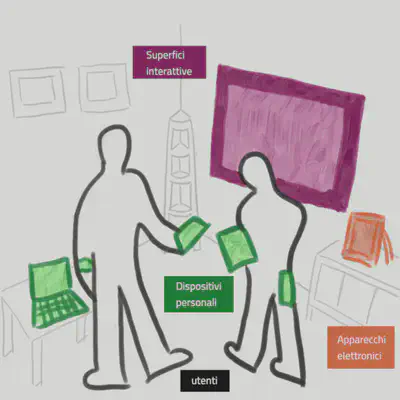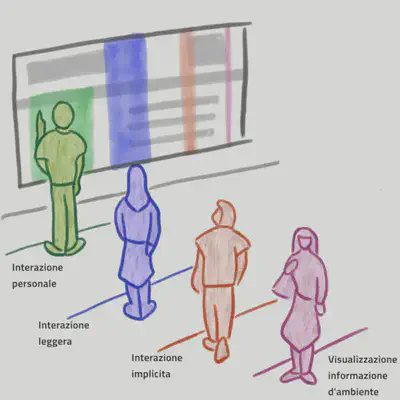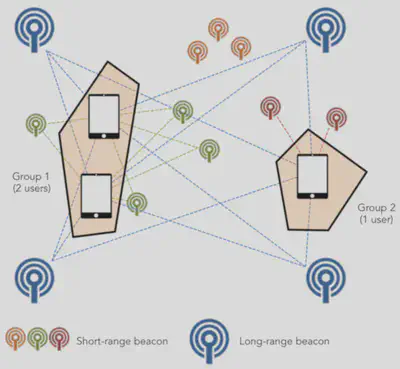EmILIE

The aim EmILIE (sEnsing ImpLicit Input and Emotions) project is to coordinate a set of sensors of consumer level, to support proxemic interaction with the different devices, also determining the user’s emotional condition. In this way, applications will opportunistically exploit the estimated values, increasing the device capabilities by sharing information.
The project was funded by the Sardinian Regional Government and by the Fondazione di Sardegna. It ended in April 2019.
Outline
Project Results
Every day we interact with a large number of devices scattered throughout the environment that surrounds us, or that we wear and carry with us (Figure 1). Although each of them is connected independently to the internet, allowing the communication with any service or application, these devices usually support the interaction with users in an isolated way. This makes it difficult to create environments that take advantage of a fully multi-device interaction, even in situations where it would be advantageous, such as in shops, museums or classrooms.

Figure 1: An example of an interactive multi-device environment. Different users can interact with different devices that are scattered within the environment. Each user can perform a task using one or more devices, and/or collaborating with other users.
The EmILIE project aims to study techniques for the detection of information on the different entities in interactive environments, coordinating and integrating data from different devices. In particular, the project focused on implicit input, i.e. on pieces of information that we can collect about both users and the environment which were not generated with the aim of interacting with a device, such as gestures, proxemics or positioning within the environment. This type of information is important for planning and implementing usable interactions on the different levels of interactivity, summarized in Figure 2.
Several pilot studies were completed within the project,
which allowed testing
consumer-level devices like simple RGB cameras, depth sensors,
microphones, or Bluetooth devices for this type of detection.

Figure 2: Different levels of interactivity based on the distance from the device. The first level supports a personal interaction with the device; the second supports a light interaction, which can also be shared between multiple users; the third is the implicit interaction, in which the device can detect information without the user explicitly sending it; the fourth is the visualization of environmental information, useful for the analysis of context in other interactions.
The results of the project are divided into five threads of work. The first is the ** proxemics and indoor location **. We developed a hardware and software architecture for identifying the location of the user’s position inside closed rooms, using a classroom as an example scenario. The system works through the use of two types of Bluetooth emitters (beacons), the first has a long range and the second a short range. The first type, positioned on the walls, allows a position estimation by triangulation. The second allows identifying objects such as furniture or equipment that, by themselves, do not support digital services. We introduced an algorithm for combining the information received by these emitters on a mobile device. We are able to provide the position of the different pupils within the classroom and to provide the teacher with a view of the groups that emerged autonomously. The functioning of the system is summarized in Figure 3.

Figure 3: Detection of a user’s position within a room. Long range beacons allow estimating the absolute position by triangulation. This information is supplemented by detection of short-range beacons that allow increasing the the accuracy of the positioning. A centralized server analyzes the position for all users in the environment and provides dynamic updates on groups that spontaneously emerged in the environment.
A second thread of work is the development and application of machine learning techniques for the ** recognition of user activities **, taking advantage of the implicit input collected through different sensors. During the course of the project, we developed several techniques to solve basic problems in using data collected during the analysis phase, as in the case of high dimensionality or in the case of one strongly unbalanced class distributions. We studied and implemented ensamble techniques to improve the stability and the effectiveness of detection. We evaluated the robustness of different techniques for selecting attributes with respect to a perturbation input data. These techniques, generally valid for different types of data, have been applied in the project case study of activity recognition. In particular, we experimented the personalization of the recognition of a whole set activities based on the characteristics and physical abilities of the user, for the personalising digital services based on the context of use, through the recognition of daily activities (such as walking, running, washing etc.) and for customizing the definition of the list of activities to be recognized within the interactive environments (e.g. a smart home) based on user feedback, allowing a simple integration of new sensors to refine activities recognized.
The third thread of work is developing methods and techniques for the ** description and recognition of interactive gestures **. This particular form of input allows obtaining important information both when the movement is performed consciously and unconsciously. We developed a modeling technique based on the composition of basic geometric elements (points, lines and arcs). This allows developers to define interactive gestures as the temporal evolution of trajectories formed by these elements. The technique has a twofold advantage: on the one hand it allows the programmer to define gestures with a specific language, obtaining an accurate recognizer for both the entire gesture and its parts. On the other hand, the approach supports the user guidance during the execution of the gesture, by supporting partial recognition. This increases the usability of the gestural systems, since it facilitates the discovery and the execution of gestures, mitigating the problem of choosing an interaction vocabulary bounded to the recognition capability of the tracking devices.
The fourth thread of work was the ** extraction of knowledge from natural language**. We proposed an algorithm that, starting with a small set of co-hyperonym words (such as Italy, France, Germany), returns a longer list of items (e.g., Spain, Portugal, Poland …) in an unsupervised manner (i.e. without the intervention of a human), simply by interpreting automatically of the texts provided as input. This allows the extraction of structured knowledge on a given domain or activity simply by analyzing the descriptions in natural language. An evolution of this system allows, in a semi-supervised mode, to answer independently to users’ questions in natural language, using automatically-learned knowledge. During the experimentation, the approach has been applied to open data on the expenditure of governments of different countries, obtaining encouraging results. A similar technique has been also applied to the documentation and code of software libraries (in Java language), creating a queryable ontology (CodeOntology) for various purposes, such as software engineering or Computational question answering.
The fifth thread of work includes techniques for the ** demonstration of ownership ** on the collected data , in order to make it easier to save and analyse data effectively. The results in this line have led to the development of techniques to identify analogies between the various pieces of information, so as to eliminate unnecessary duplication. This allowed us to understand how different alternatives in various evolutions can be compacted, introducing the concept of merging relations, which has so far found application in Petri Nets. Finally, we focused on defining models for the demonstration of formal properties related to correctness and completeness of contracts for the use of data and the execution of services, which allows proving properties to the service users.
The Research Group
The project was developed in the Department of Mathematics and Computer Science, University of Cagliari, Italy. The research group includes the following professors:
- Lucio Davide Spano. Human Computer Interaction. Principal Investigator.
- Barbara Pes. Data Mining. Knowledge Extraction.
- Daniele Riboni. Pervasive Computing. Proxemics and Activity Recognition.
- Riccardo Scateni. Computer Graphics. Geometry Processing.
- Giovanni Puglisi. Computer Vision. Video and Image processing.
- Diego Reforgiato. Sentiment Analysis. Emotion Recognition.
- Maurizio Atzori. Semantic Web. Knowledge Representation and Natural Language Processing.
- Massimo Bartoletti. Security. Trustworthy Services .
- Michele Pinna. Formal Methods. Parallel Computing.
Project Publications
2019
- Alessandro Carcangiu, Lucio Davide Spano, Giorgio Fumera, Fabio Roli. DEICTIC: A compositional and declarative gesture description based on hidden markov models. Int. J. Hum.-Comput. Stud. 122: 113-132 (2019).
- Alessandro Carcangiu, Lucio Davide Spano: Integrating declarative models and HMMs for online gesture recognition. IUI Companion 2019: 87-88
- M. Bartoletti, B. Bellomy, L. Pompianu. A journey into Bitcoin metadata. In Journal of Grid Computing, 2019. Paper
- M. Bartoletti, R. Zunino. Verifying liquidity of Bitcoin contracts. In Proc. POST, 2019. Paper
- Roberto Cocco, Maurizio Atzori, Carlo Zaniolo. Machine Learning of SPARQL Templates for Question Answering over LinkedSpending. 28th IEEE International Conference on Enabling Technologies: Infrastructure for Collaborative Enterprises (IEEE WETICE 2019), DEW Track (DEW 2019) (2019)
- Barbara Pes. Handling class imbalance in high-dimensional biomedical datasets. 28th IEEE International Conference on Enabling Technologies: Infrastructure for Collaborative Enterprises (WETICE 2019), June 12-14, 2019, Capri (Napoli), Italy, to appear.
- Barbara Pes. Ensemble feature selection for high-dimensional data: a stability analysis across multiple domains. Neural Computing and Applications, 2019. 10.1007/s00521-019-04082-3.
- Assunta Matassa, Daniele Riboni. Reasoning with Smart Objects’ Affordance for Personalized Behavior Monitoring in Pervasive Information Systems. Knowledge and Information Systems, Springer, 2019. To appear.
- Daniele Riboni, Opportunistic Pervasive Computing: Adaptive Context Recognition and Interfaces. CCF Transactions on Pervasive Computing and Interaction, Springer, 2019. 10.1007/s42486-018-00004-9.
2018
- Fabio Marco Caputo, Pietro Prebianca, Alessandro Carcangiu, Lucio Davide Spano, Andrea Giachetti: Comparing 3D trajectories for simple mid-air gesture recognition. Computers & Graphics 73: 17-25 (2018)
- Matteo Serpi, Alessandro Carcangiu, Alessio Murru, Lucio Davide Spano: Web5VR: A Flexible Framework for Integrating Virtual Reality Input and Output Devices on the Web. PACMHCI 2: 4:1-4:19 (2018)
- Alessandro Carcangiu, Lucio Davide Spano: G-Gene: A Gene Alignment Method for Online Partial Stroke Gestures Recognition. PACMHCI 2: 13:1-13:17 (2018)
- M. Bartoletti, B. Pes, S. Serusi. Data mining for detecting Bitcoin Ponzi schemes. In Proc. Crypto Valley Conference on Blockchain Technology, 2018 Paper
- M. Bartoletti, T. Cimoli, L. Pompianu, S. Serusi. Blockchain for social good: a quantitative analysis. Presented at Goodtechs, 2018 Paper
- M. Bartoletti, T. Cimoli, R. Zunino. Fun with Bitcoin smart contracts. In Proc. ISOLA, 2018. Paper
- M. Bartoletti, L. Bocchi, M. Murgia. Progress-preserving Refinements of CTA. In Proc. CONCUR, 2018 Paper
- M. Bartoletti, R. Zunino. BitML: a calculus for Bitcoin smart contracts. In Proc. ACM CCS, 2018. Also available as Cryptology ePrint Archive 2018/122, 2018 Paper
- N. Atzei, M. Bartoletti, S. Lande, R. Zunino. A formal model of Bitcoin transactions. In Proc. Financial Cryptography, 2018 Paper
- N. Atzei, M. Bartoletti, T. Cimoli, S. Lande, R. Zunino. SoK: unraveling Bitcoin smart contracts. In Proc. POST, 2018. Paper
- Gabriele Civitarese, Claudio Bettini, Timo Sztyler, Daniele Riboni, Heiner Stuckenschmidt, NECTAR: Knowledge-based Collaborative Active Learning for Activity Recognition. In Proceedings of the 2018 IEEE International Conference on Pervasive Computing and Communications (PerCom), IEEE Computer Society, 2018.
- Barbara Pes. Evaluating Feature Selection Robustness on High-Dimensional Data. 13th International Conference on Hybrid Artificial Intelligence Systems (HAIS 2018), Oviedo, Spain, June 20-22, 2018, LNCS, vol 10870, pp 235-247, Springer. 10.1007/978-3-319-92639-1_20.
- Carlo Zaniolo, Shi Gao, Maurizio Atzori, Muhao Chen, Jiaqi Gu. User-Friendly Temporal Queries on Historical Knowledge Bases Information and Computation, Time 2015 special issue, Elsevier (2018)
- Maurizio Atzori, Simone Balloccu and Andrea Bellanti. Unsupervised Singleton Expansion from Free Text. ICSC 2018 - 10th IEEE International Conference on Semantic Computing (2018)
2017
- Martina Senis, Giovanni Atzori, Fabio Sorrentino, Lucio Davide Spano, Gianni Fenu: Smart Furniture and Technologies for Supporting Distributed Learning Groups. CHItaly 2017: 11:1-11:6
- Fabio Sorrentino, Lucio Davide Spano, Sara Casti, Alessandro Carcangiu, Fabrizio Corda, Gianmarco Cherchi, Alessio Murru, Alessandro Muntoni, Stefano Nuvoli, Riccardo Scateni: ChIP: Teaching Coding in Primary Schools. DCPD@CHItaly 2017: 106-110
- Giovanni Casu, G. Michele Pinna, Merging Relations: A Way to Compact Petri Nets’ Behaviors Uniformly, in Proceeding of LATA 2017, Lecture Notes in Computer Science 10168, pp. 325–337, 2017.
- Fabio Marco Caputo, Pietro Prebianca, Alessandro Carcangiu, Lucio Davide Spano, Andrea Giachetti: A 3 Cent Recognizer: Simple and Effective Retrieval and Classification of Mid-air Gestures from Single 3D Traces. Eurographics Italian Chapter Conference 2017: 9-15
- N. Atzei, M. Bartoletti, T. Cimoli. A survey of attacks on Ethereum smart contracts (SoK). In Proc. POST, 2017 Paper
- M. Bartoletti, A. Bracciali, S. Lande, L. Pompianu. A general framework for blockchain analytics. In Proc. SERIAL, 2017 Paper
- Mattia Atzeni, Maurizio Atzori. CodeOntology: RDF-ization of Source Code.
ISWC 2017 - Proceedings of the 16th International Semantic Web Conference, Resource Track (2017) - Atzeni Mattia, Maurizio Atzori. CodeOntology: Querying Source Code in a Semantic Framework. ISWC 2017 - Proceedings of the 16th International Semantic Web Conference, Demo Paper (2017)
- Maurizio Atzori, Ludovico Boratto, Lucio Davide Spano. Towards Chatbots as Recommendation Interfaces. 2nd Workshop on Engineering Computer-Human Interaction in Recommender Systems (EnCHIReS 2017) part of 9th ACM SIGCHI Symposium on Engineering Interactive Computing Systems (EICS 2017), 26-29 June, 2017 Lisbon, Portugal (2017)